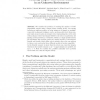Free Online Productivity Tools
i2Speak
i2Symbol
i2OCR
iTex2Img
iWeb2Print
iWeb2Shot
i2Type
iPdf2Split
iPdf2Merge
i2Bopomofo
i2Arabic
i2Style
i2Image
i2PDF
iLatex2Rtf
Sci2ools
116
click to vote
ALGOSENSORS
2007
Springer
2007
Springer
Counting Targets with Mobile Sensors in an Unknown Environment
Abstract. We consider the problem of counting the number of indistinguishable targets using a simple binary sensing model. Our setting includes an unknown number of point targets in a (simple or multiplyconnected) polygonal workspace, and a moving point-robot whose sensory input at any location is a binary vector representing the cyclic order of the polygon vertices and targets visible to the robot. In particular, the sensing model provides no coordinates, distance or angle measurements. We investigate this problem under two natural models of environment, friendly and hostile, which differ only in whether the robot can walk up to them or not, and under three different models of motion capability. In the friendly scenario we show that the robots can count the targets, whereas in the hostile scenario no (2 − ε)-approximation is possible, for any ε > 0. Next we consider two, possibly minimally more powerful robots that can count the targets exactly. 1 The Problem and the Model Si...
ALGOSENSORS 2007 | Indistinguishable Targets | Sensing Model | Simple Binary Sensing | Wireless Sensors |
Related Content
| Added | 07 Jun 2010 |
| Updated | 07 Jun 2010 |
| Type | Conference |
| Year | 2007 |
| Where | ALGOSENSORS |
| Authors | Beat Gfeller, Matús Mihalák, Subhash Suri, Elias Vicari, Peter Widmayer |
Comments (0)

